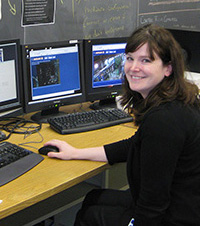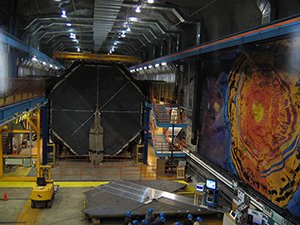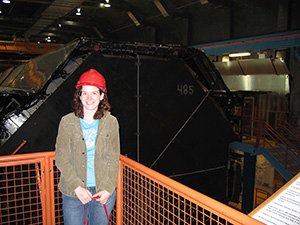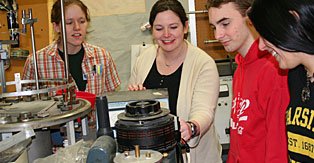Dr. Emily Maher
Professor, Physics

- emily.maher@mcla.edu
- Phone
- (413) 662-5268
- Office
- Center for Science & Innovation 110C
Research
My research field is experimental particle physics. The universe is made of 12 fundamental particles: electron, electron neutrino, muon, muon neutrino, tau, tau neutrino, up quark, down quark, charm quark, strange quark, top (or truth) quark, and bottom (or beauty) quark. Of these 12 particles, I am most interested in the neutrinos, which come in three types: electron neutrino, muon neutrino, and tau neutrino. These guys are the most abundant particles in the universe, but we know the least about them. In fact, for a long time we thought they were massless, but now we know better.
Neutrinos are difficult to study because they are virtually massless, they are neutral, and they only interact through the weak interaction. This means neutrinos almost never interact. In fact, if we took a bunch of neutrinos produced inside the sun and we sent them through a light-year of lead, only about HALF of them would interact. The other half would travel right through a light-year of lead as if it were nothing! By the way, you have about 65 billion neutrinos traveling through your fingertip each second.
 The only way we can "see" an elementary particle is through its electromagnetic interaction.
Of course, the neutrino is neutral, so it doesn't interact through the electromagnetic
force. We can only "see" neutrinos when they interact with other particles. But, from
above, we know they don't interact very often. To see a neutrino interact, we must
send MANY, MANY neutrinos through a very MASSIVE target. Then, occasionally, the neutrino
will interact, and we will see the particles that are produced in the interaction.
We use those particles to study the interaction of the neutrino and the neutrino itself.
A good analogy: if you are walking through a snowy forest, and you see tracks, you
can tell which animal was there. You don't see the animal, but you see its interaction
with the snow.
The only way we can "see" an elementary particle is through its electromagnetic interaction.
Of course, the neutrino is neutral, so it doesn't interact through the electromagnetic
force. We can only "see" neutrinos when they interact with other particles. But, from
above, we know they don't interact very often. To see a neutrino interact, we must
send MANY, MANY neutrinos through a very MASSIVE target. Then, occasionally, the neutrino
will interact, and we will see the particles that are produced in the interaction.
We use those particles to study the interaction of the neutrino and the neutrino itself.
A good analogy: if you are walking through a snowy forest, and you see tracks, you
can tell which animal was there. You don't see the animal, but you see its interaction
with the snow.

I began working with the elusive neutrino in graduate school. I worked on an experiment called DONuT (Direct Observation for Nu Tau). You can find some information about DONuT here. The goal of the DONuT experiment was the FIRST observation of the tau neutrino. The electron and muon neutrinos were observed decades earlier, but the tau-neutrino was difficult to observe. When a tau neutrino interacts (through the charged-current interaction), it produces a tau particle. If we see a tau particle (along with no other leptons), then we have seen a tau neutrino interact. The problem is the tau - it is a heavy, short-lived particle. The taus in DONuT only traveled ~ 5mm before decaying. We had to use a detector made of photographic film to capture a picture of the tau lepton. But we did, and we saw 9 tau neutrinos!!! You can read our last paper here:
Final tau-neutrino results from the DONuT experiment
By the way, all of these experiment are done at Fermilab, which is an amazing particle physics laboratory.
While in graduate school, I also worked on the MINOS experiment. We shot a beam of muon neutrinos from Fermilab, a lab outside of Chicago, through the earth and into an underground iron mine in Northern Minnesota. (I promise, I am not making this up.) The goal of this experiment was to catch neutrinos changing flavor, meaning a muon neutrino changes to a tau neutrino. You can read more about MINOS here. MINOS did, indeed, find that these neutrinos were changing flavor. They did this by counting all of the muon neutrinos made at Fermilab and counting all of the muon neutrinos that arrived in Northern Minnesota (this is not nearly as easy as I made it sound). There were fewer muon neutrinos than expected in Northern Minnesota. The fact that neutrinos oscillate mean that neutrinos cannot be massless. This is direct evidence for physics beyond the Standard Model! Here are a couple of papers from the MINOS collaboration:
First Observations of Separated Atmospheric ν µ and ν µ Events in the MINOS Detector
Observation of muon neutrino disappearance with the MINOS detectors in the NuMI neutrino beam

Current, I am working on the MINERvA experiment. Again, we are studying neutrinos. This time, we are trying to measure the probability that neutrinos interact, and, when they do interact, which types of particles do they create and how often do they create that set of particles. You can read more about MINERvA here. In addition to studying neutrinos, we are actually using neutrinos to study what happens inside the nucleus. It turns out there is all kind of crazy stuff happening inside of the nucleus that we don't understand. For example, the first MINERvA results suggest that neutrons and protons like to hang out in pairs inside the nucleus - who knew they were so social? Here is an article that ran in the CERN courier about this result:
MINERvA searches for wisdom among neutrinos
Below you will find my list of publications, where you can read much more about all of these experiments.
EDUCATIONPh.D., Physics, University of Minnesota, B.A., Physics, Hendrix College, 1999 |
COURSES TAUGHTCCST 101: Concepts in Physics CCST 103: Quarks to Quasars CCST 106: Physics of Superheroes CCST 230: Energy & the Environment PHYS 151: Intro to Mechanics PHYS 251: Intro to Electricity and Magnetism PHYS 252: Intro to Waves, Optics, and Relativity PHYS 301: Classical Mechanics PHYS 303: Electricity and Magnetism PHYS 305: Electronics PHYS 351: Modern Physics PHYS 361: Mathematical Physics PHYS 403: Intro to Particle Physics PHYS 471: Quantum Mechanics PHYS 401: Advanced Lab I PHYS 402: Advanced Lab II PHYS 580: Computational Physics in Python PHYS 580: General Relativity DataCamp is a wonderful resources for learning to program in Python, R, and other languages. |
Publications
“Measurement of the axial vector form factor from antineutrino-proton scattering” Nature, 614, 48-53 (2023)
“High-Statistics Measurement of Antineutrino Quasielastic-like scattering at Eν∼ 6~GeV
on a Hydrocarbon Target” MINERvA Collaboration, arXiv:2211.10402, submitted for publication
“Simultaneous measurement of νμ charged-current single π+ production in CH, C, H2O,
Fe, and Pb targets in MINERvA” MINERvA Collaboration, arXiv: 2209.07852, submitted for publication
“Neutrino-induced coherent π+ production in C, CH, Fe and Pb at ⟨Eν⟩∼6 GeV” MINERvA Collaboration, arXiv: 2210:01285, submitted for publication
“Improved constraint on the MINERvA medium energy neutrino flux using ν¯e−→ν¯e− data” MINERvA Collaboration, Phys. Rev. D 107, 012001 (2023)
“Simultaneous measurement of proton and lepton kinematics in quasielastic-like νμ-hydrocarbon interactions from 2 to 20 GeV” MINERvA Collaboration, Phys.Rev.Lett. 129 (2022) 2, 021803
“Vertex finding in neutrino-nucleus interaction: A Model Architecture Comparison” MINERvA Collaboration, Journal of Instrumentation 17 T08013 (2022)
“Measurement of inclusive charged-current muon neutrino scattering on hydrocarbon at ⟨Eν⟩∼6 GeV with low three-momentum transfer” MINERvA Collaboration, Phys.Rev.D 106 (2022) 3, 032001
“Exploring Neutrino-Nucleus Interactions in the GeV Regime using MINERvA” MINERvA Collaboration, Eur.Phys.J.ST 230 (2021) 24, 4243-4257
“Constraining the NuMI neutrino flux using inverse muon decay reactions in MINERvA” MINERvA Collaboration, Phys.Rev.D 104 (2021) 9, 092010
“Measurement of inclusive charged-current νμ cross sections as a function of muon kinematics at <Eν>∼6 GeV on hydrocarbon” MINERvA Collaboration, Phys.Rev.D 104 (2021) 9, 092007
“Use of Neutrino Scattering Events with Low Hadronic Recoil to Inform Neutrino Flux and Detector Energy Scale” MINERvA Collaboration, Journal of Instrumentation 16 P08068 (2021)
“Neutral pion reconstruction using machine learning in the MINERvA experiment at ⟨Eν⟩∼6 GeV” MINERvA Collaboration, Journal of Instrumentation 16 P07060 (2021)
“Double-Differential Inclusive Charged-Current muon neutrino Cross Sections on Hydrocarbon in MINERvA at ⟨Eν⟩∼ 3.5 GeV” MINERvA Collaboration, Phys. Rev. D 101, 11 (2020)
“Probing Nuclear Effects with Neutrino-induced Charged-Current Neutral Pion Production” MINERvA Collaboration, Phys. Rev. D 102, 072007 (2020)
“High-statistics measurement of neutrino quasielastic-like scattering at ~6 GeV on a hydrocarbon target” MINERvA Collaboration, Phys. Rev. Lett. 124, 121801 (2020)
“Nuclear binding energy and transverse momentum imbalance in neutrino-nucleus reaction “ MINERvA Collaboration, Phys.Rev. D 101, 092001 (2020)
“Constraint of the MINERvA Medium Energy Neutrino Flux using Neutrino-Electron Elastic Scattering” MINERvA Collaboration, Phys.Rev. D 100, 9 (2019)
“Measurement of muon anti-neutrino charged-current single π− production on hydrocarbon in the few-GeV region using MINERvA” MINERvA Collaboration, Phys. Rev. D 100, 5 (2019)
“Tuning the GENIE Pion Production Model with MINERvA Data” MINERvA Collaboration, Phys.Rev. D 100, 7 (2019)
“Neutron measurements from anti-neutrino hydrocarbon reactions” MINERvA Collaboration, Phys. Rev. D 100, 052002 (2019)
“Measurement of Quasielastic-Like Neutrino Scattering at ⟨Eν⟩∼3.5 GeV on a Hydrocarbon Target” MINERvA Collaboration, Phys. Rev. D 99, 012004 (2019)
“Reducing model bias in a deep learning classifier using domain adversarial neural networks in the MINERvA experiment,” MINERvA Collaboration, Journal of Instrumentation, Vol. 13 (2018)
“Measurement of final-state correlations in neutrino muon-proton mesonless production on hydrocarbon at ⟨Eν⟩ = 3 GeV,” MINERvA Collaboration, Phys. Rev. Lett. 121, 022504 (2018)
“Antineutrino charged Current charged-current reactions on scintillator with low momentum transfer,” MINERvA Collaboration, Phys. Rev. Lett. 120, 221805 (2018)
“Measurement of the muon anti-neutrino double-differential cross section for quasi-elastic scattering on hydrocarbon at~Eν∼3.5GeV,” MINERvA Collaboration, Phys. Rev. D 97, 052002 (2018)
“Measurement of Total and Differential Cross Sections of Neutrino and Antineutrino Coherent π± Production on Carbon,” MINERvA Collaboration, accepted by Physical Review D (2018)
“Measurement of νμ charged-current single π0 production on hydrocarbon in the few-GeV region using MINERvA,” MINERvA Collaboration, Phys. Rev. D 96, 072003 (2017)
"Direct Measurement of Nuclear Dependence of Charged Current Quasielastic-like Neutrino Interactions using MINERvA,” MINERvA Collaboration, Phys. Rev. Lett. 119, 082001 (2017)
" Measurement of the antineutrino to neutrino charged-current interaction cross section ratio on carbon,” MINERvA Collaboration, Phys. Rev. D 95, 072009 (2017)
Measurement of the Neutral-current K+ Production by Neutrinos Using MINERvA," C.M. Marshall, et al. (MINERvA Collaboration). Phys. Rev. Lett. 199, 011802 (2017)
“Measurement of the Inclusive Neutrino and Antineutrino Charged Current Cross Sections in MINERvA Using the Low-nu Flux Method," J. DeVan, et al. (MINERvA Collaboration). Phys. Rev. D 94,112007 (2016)
"Neutrino Flux Predictions for the NuMI Beam," L. Aliaga, et al. (MINERvA Collaboration). Phys. Rev. D 94, 092005 (2016)
"Measurement of K+ Production in Charged-Current muon neutrino Interactions,'' C. M. Marshall, et al. (MINERvA Collaboration). Phys. Rev. Lett. 117, 061802 (2016)
"First Evidence of Coherent K+ Meson Production in Neutrino-Nucleus Scattering", C. M. Marshall, et al. (MINERvA Collaboration). Phys. Rev. Lett. 117, 061802 (2016)
"Cross Sections for Neutrino and Antineutrino Induced Pion Production on Hydrocarbon in the Few-GeV region using MINERvA", C. L. McGivern, et al. (MINERvA collaboration). Phys. Rev. D 94, 052005 (2016)
"Evidence for Neutral-Current Diffractive Neutral Pion Production from Hydrogen in Neutrino Interactions on Hydrocarbon", J. Wolcott, et al. (MINERvA Collaboration). Phys. Rev. Lett. 117, 111801 (2016)
"Measurement of the K+ production in charged-current muon neutrino interactions", C. M. Marshall, et al. (MINERvA collaboration). Physical Review D 94, 012002 (2016)
"Measurement of Partonics Nuclear Effects in Deep-Inelastic Neutrino Scattering using MNERvA", J. Mousseau et al. (MINERvA Collaboration). Physical Review D 93, 071101 (2016)
"Measurement of the Neutrino Flux from Neutrino-Electron Elastic Scattering", J. Park, et al. (MINERvA Collaboration). Phys. Rev. D 93, 112007 (2016)
"Identification of Nuclear Effects in Neutrino-carbon Interactions at Low Three-momentum Transfer", P. Rodrigues et al. (MINERvA Collaboration). Phys. Rev. Lett. 116, 071802 (2016)
"Measurement of Electron Neutrino Quasielastic and Quasielastic-like Scattering on Hydrocarbon at Average Energy of 3.6 GeV", J. Wolcott et al. (MINERvA Collaboration). Phys. Rev. Lett 116, 081802 (2016)
"Charged Pion Production in muon neutrino interactions on hydrocarbons at = 4.0 GeV'', B. Eberly et al. (MINERvA Collaboration). Physics Review D 92, 092008 (2015)
"Single neutral pion production by charged-current anti-neutrino interactions on hydrocarbon at an average neutrino energy of 3.6 GeV", T. Le et al. (MINERvA Collaboration). Physics Letters B749 130-136. (2015)
"MINERvA neutrino detector response measured with test beam data", L. Aliaga et al. (MINERvA Collaboration) Nucl. Inst. Meth. A 789, pp 28-42. (2015)
"Measurement of muon proton final states in muon-neutrino interaction on hydrocarbon at =4.0GeV'', T. Walton et al. (MINERvA Collaboration). Phys. Rev. D 91, 071301. (2015)
"Measurement of Coherent Production of Pi+ and Pi- in Neutrino and Anti-Neutrino Beams on Carbon from neutrinos energy of 1.5 to 20 GeV", A. Higuera, A. Mislivec, et al. (MINERvA Collaboration). Phys. Rev. Lett. 113, 261802 (2014)
"MINERvA Searches for Wisdom Among Neutrinos'', E. Maher, D. Harris, and K. McFarland, CERN Courier, April, 2014, 26-29. (2014)
"Measurement of Ratios of Muon Neutrino Charged-Current Cross Sections on C, Fe, and Pb to CH at Neutrino Energies 2-20 GeV'', B.G. Tice et al. (MINERvA Collaboration) Phys. Rev. Lett. 112, 231801. (2014)
"Design, Calibration, and Performance of the MINER$\nu$A Detector", L. Aliagia, et al., Nuclear Instruments and Methods, A743 (2014) 130. (2014)
"Measurement of Muon Neutrino Quasi-Elastic Scattering on a Hydrocarbon Target at ~ 3.5 GeV'', G. A. Fiorentini, D. W. Schmitz, P. A. Rodrigues et al. (MINERvA Collaboration), Phys. Rev. Lett. 111, 022502. (2013)
"Measurement of Muon Antineutrino Quasi-Elastic Scattering on a Hydrocarbon Target at ~ 3.5 GeV'', L. Fields, J. Chvojka et al. (MINERvA Collaboration), Phys. Rev. Lett. 111, 022501. (2013)
"The MINERvA Data Acquisition System and Infrastructure", G. N. Perdue, et al. (MINERvA Collaboration), Nuclear Instruments and Methods A: Volume 694, 179. (2012)
"Demonstration of Communication using Neutrinos", D. D. Stancil, et al. (MINERvA Collaboration), Modern Physics Letters A 27, 1250077. (2012)
"Arachne - A web-based event viewer for MINERvA", N. Tagg, et al. (MINERvA Collaboration), Nuclear Instruments and Methods, v. 676, 44. (2012)
"A First Measurement of the Interaction Cross Section of the Tau Neutrino", K. Kodama, et al., Physical Review D78. (2008)
"Observation of Muon Neutrino Disappearance with the MINOS Detectors in the NuMI Neutrino Beam", D. G. Michael, et al., Phys. Rev. Lett. 97, 191801. (2006)
"First Observation of Separated Atmospheric Muon Neutrino and Muon Anti-neutrino Events in the MINOS Detector'', P. Adamson et al., Phys. Rev. Lett. 97, 191801. (2006)
Talks and Presentations
Careers in Education Panel Member at the Conference for Undergraduate Women in Physics (CUWiP), University of Massachusetts, Amherst, 2019
"Seeing the Invisible: Neutrinos, Fermilab, and the MINERvA Experiment", presented at the MCLA Brown Bag Lecture Series, 2015
"Recent Results from the MINERvA Experiment", presented at the Lake Louise Winter Institute 2015 at Chateau Lake Louise in Alberta, Canada, 2015
"Neutrinos and the MINERvA Experiment", presented at the Physics and Astronomy Colloquium Series at Union College, Schenectady, NY, 2014
"Anti-Neutrino Quasi-Elastic Scattering at MINERvA", presented at the American Society of Physics Division of Nuclear Physics annual meeting, Newport Beach, CA, 2012
"Neutrinos and the MINERvA Experiment", presented at the Physics Colloquium at Bates College, Lewiston, ME, 2011
"Absolute Calibration of the MINERvA Detector", presented at American Physical Society April Meeting 2010, Washington DC, 2010
“Final Tau-Neutrino Results from the DONuT Experiment”, presented at the Physics Colloquium at Williams College, Williamstown, MA, 2008
